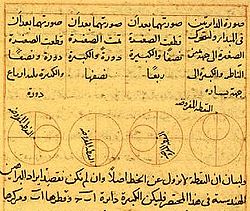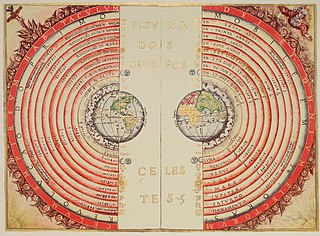
In astronomy, the geocentric model is a superseded description of the Universe with Earth at the center. Under most geocentric models, the Sun, Moon, stars, and planets all orbit Earth. The geocentric model was the predominant description of the cosmos in many European ancient civilizations, such as those of Aristotle in Classical Greece and Ptolemy in Roman Egypt, as well as during the Islamic Golden Age.

In the Hipparchian, Ptolemaic, and Copernican systems of astronomy, the epicycle was a geometric model used to explain the variations in speed and direction of the apparent motion of the Moon, Sun, and planets. In particular it explained the apparent retrograde motion of the five planets known at the time. Secondarily, it also explained changes in the apparent distances of the planets from the Earth.
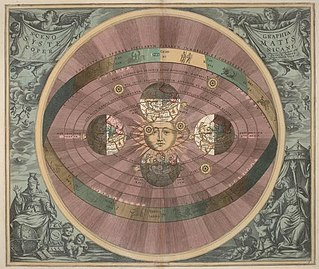
Heliocentrism is a superseded astronomical model in which the Earth and planets revolve around the Sun at the center of the universe. Historically, heliocentrism was opposed to geocentrism, which placed the Earth at the center. The notion that the Earth revolves around the Sun had been proposed as early as the third century BC by Aristarchus of Samos, who had been influenced by a concept presented by Philolaus of Croton. In the 5th century BC the Greek Philosophers Philolaus and Hicetas had the thought on different occasions that the Earth was spherical and revolving around a "mystical" central fire, and that this fire regulated the universe. In medieval Europe, however, Aristarchus' heliocentrism attracted little attention—possibly because of the loss of scientific works of the Hellenistic period.
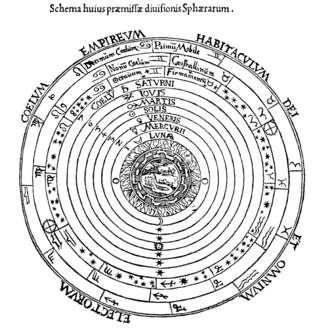
The celestial spheres, or celestial orbs, were the fundamental entities of the cosmological models developed by Plato, Eudoxus, Aristotle, Ptolemy, Copernicus, and others. In these celestial models, the apparent motions of the fixed stars and planets are accounted for by treating them as embedded in rotating spheres made of an aetherial, transparent fifth element (quintessence), like gems set in orbs. Since it was believed that the fixed stars did not change their positions relative to one another, it was argued that they must be on the surface of a single starry sphere.

Equant is a mathematical concept developed by Claudius Ptolemy in the 2nd century AD to account for the observed motion of the planets. The equant is used to explain the observed speed change in different stages of the planetary orbit. This planetary concept allowed Ptolemy to keep the theory of uniform circular motion alive by stating that the path of heavenly bodies was uniform around one point and circular around another point.

ʿAbu al-Ḥasan Alāʾ al‐Dīn bin Alī bin Ibrāhīm bin Muhammad bin al-Matam al-Ansari known as Ibn al-Shatir or Ibn ash-Shatir was an Arab astronomer, mathematician and engineer. He worked as muwaqqit in the Umayyad Mosque in Damascus and constructed a sundial for its minaret in 1371/72.

Al-Urdi was a medieval Syrian Arab astronomer and geometer.
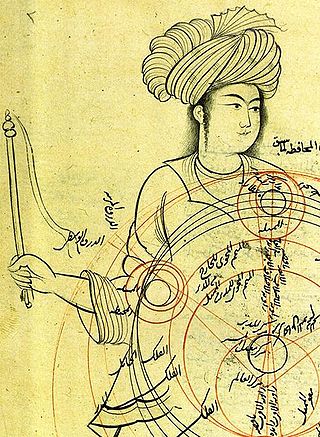
Qotb al-Din Mahmoud b. Zia al-Din Mas'ud b. Mosleh Shirazi was a 13th-century Persian polymath and poet who made contributions to astronomy, mathematics, medicine, physics, music theory, philosophy and Sufism.
Nur ad-Din al-Bitruji was an Andalusian-Arab astronomer and a Qadi in al-Andalus. Al-Biṭrūjī was the first astronomer to present a non-Ptolemaic astronomical system as an alternative to Ptolemy's models, with the planets borne by geocentric spheres. Another original aspect of his system was that he proposed a physical cause of celestial motions. His alternative system spread through most of Europe during the 13th century.

Medieval Islamic astronomy comprises the astronomical developments made in the Islamic world, particularly during the Islamic Golden Age, and mostly written in the Arabic language. These developments mostly took place in the Middle East, Central Asia, Al-Andalus, and North Africa, and later in the Far East and India. It closely parallels the genesis of other Islamic sciences in its assimilation of foreign material and the amalgamation of the disparate elements of that material to create a science with Islamic characteristics. These included Greek, Sassanid, and Indian works in particular, which were translated and built upon.
Zīj-i Īlkhānī or Ilkhanic Tables is a Zij book with astronomical tables of planetary movements. It was compiled by the Muslim astronomer Nasir al-Din al-Tusi in collaboration with his research team of astronomers at the Maragha observatory. It was written in Persian and later translated into Arabic.
Islamic cosmology is the cosmology of Islamic societies. It is mainly derived from the Qur'an, Hadith, Sunnah, and current Islamic as well as other pre-Islamic sources. The Qur'an itself mentions seven heavens.

The Maragheh observatory, also spelled Maragha, Maragah, Marageh, and Maraga, was an astronomical observatory established in the mid 13th century under the patronage of the Ilkhanid Hulagu and the directorship of Nasir al-Din al-Tusi, a Persian scientist and astronomer. The observatory is located on the west side of Maragheh, which is situated in today's East Azerbaijan Province of Iran. It was considered one of the most advanced scientific institutions in Eurasia because it was a center for many groundbreaking calculations in mathematics and astronomy. It housed a large collection of astronomical instruments and books and it served as an educational institution. It was also used as a model for the later Ulugh Beg Observatory in Samarkand, the Taqi al-Din observatory in Constantinople, and Jai Singh observatory in Jaipur.

Copernican heliocentrism is the astronomical model developed by Nicolaus Copernicus and published in 1543. This model positioned the Sun at the center of the Universe, motionless, with Earth and the other planets orbiting around it in circular paths, modified by epicycles, and at uniform speeds. The Copernican model displaced the geocentric model of Ptolemy that had prevailed for centuries, which had placed Earth at the center of the Universe.

Scientific scholarship during the Byzantine Empire played an important role in the transmission of classical knowledge to the Islamic world and to Renaissance Italy, and also in the transmission of Islamic science to Renaissance Italy. Its rich historiographical tradition preserved ancient knowledge upon which splendid art, architecture, literature and technological achievements were built. Byzantines stood behind several technological advancements.

Abdal Ali ibn Muhammad ibn Husayn Birjandi was a prominent 16th-century Persian astronomer, mathematician and physicist who lived in Birjand.
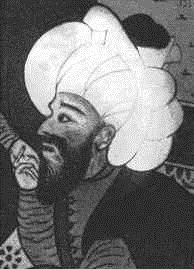
Ala al-Dīn Ali ibn Muhammed, known as Ali Qushji was a Timurid theologian, jurist, astronomer, mathematician and physicist, who settled in the Ottoman Empire some time before 1472. As a disciple of Ulugh Beg, he is best known for the development of astronomical physics independent from natural philosophy, and for providing empirical evidence for the Earth's rotation in his treatise, Concerning the Supposed Dependence of Astronomy upon Philosophy. In addition to his contributions to Ulugh Beg's famous work Zij-i-Sultani and to the founding of Sahn-ı Seman Medrese, one of the first centers for the study of various traditional Islamic sciences in the Ottoman Empire, Ali Kuşçu was also the author of several scientific works and textbooks on astronomy.

Muhammad ibn Muhammad ibn al-Hasan al-Tusi, also known as Nasir al-Din al-Tusi or simply as (al-)Tusi, was a Persian polymath, architect, philosopher, physician, scientist, and theologian. Nasir al-Din al-Tusi was a well published author, writing on subjects of math, engineering, prose, and mysticism. Additionally, al-Tusi made several scientific advancements. In astronomy, al-Tusi created very accurate tables of planetary motion, an updated planetary model, and critiques of Ptolemaic astronomy. He also made strides in logic, mathematics but especially trigonometry, biology, and chemistry. Nasir al-Din al-Tusi left behind a great legacy as well. Tusi is widely regarded as one of the greatest scientists of medieval Islam, since he is often considered the creator of trigonometry as a mathematical discipline in its own right. The Muslim scholar Ibn Khaldun (1332–1406) considered Tusi to be the greatest of the later Persian scholars. There is also reason to believe that he may have influenced Copernican heliocentrism.

Shams al-Din Muhammad b. Ahmad al-Khafri al-Kashi, known as Khafri, was an Iranian religious scholar and astronomer at the beginning of the Safavid dynasty. Before the arrival of Sheikh Baha'i in Iran, he was appointed as the major Shia jurist in the Safavid court. He was born in the city of Ḵafr, south east of Firuzābād in the region of Fārs. His exact date of birth is unknown but historical accounts estimate the date of his birth to be around the 1480s. He wrote on philosophy, religion, and astronomy, with the latter including a commentary on al-Tusi and critiques of al-Shirazi. Al-Khafri wrote works on theology and astronomy, indicating that Islamic scholars in his time and place saw no contradictions between Islam and science.

Nasirean Ethics is a 13th century Persian book in philosophical ethics that is written by Khaje Nasir al-Din al-Tusi. This book is divided to three part: ethics, domestic economy and politics.

